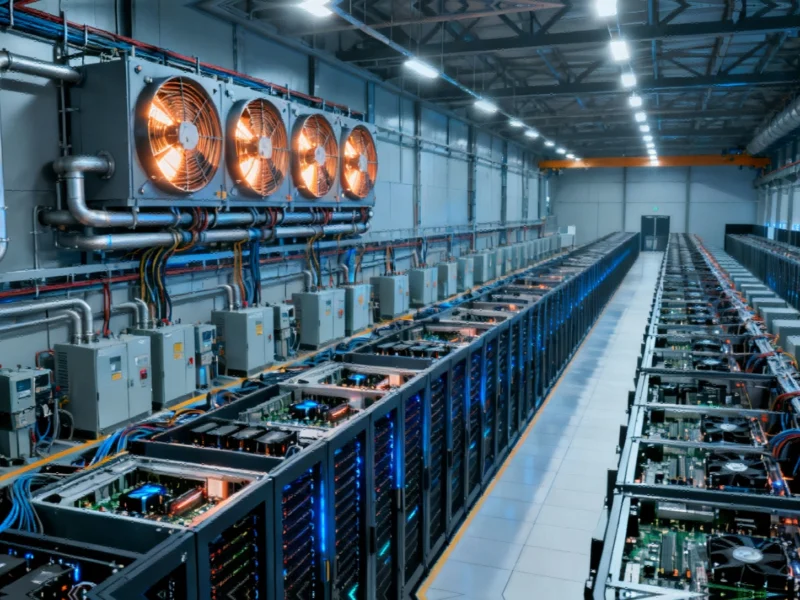The relentless expansion of artificial intelligence infrastructure is triggering an unprecedented energy crisis across America’s technology sector, with hyperscale data centers projected to consume staggering amounts of grid power that threaten to overwhelm existing utility capacities. According to new research from 451 Research (now part of S&P Global), these massive computing facilities will devour 22 percent more electricity by the end of 2025 compared to last year’s consumption levels.
The accelerating power demand reflects what industry analysts describe as a fundamental transformation in computing infrastructure driven by generative AI and machine learning workloads. As detailed in a comprehensive analysis of hyperscale data center projections, the sector’s energy requirements are expected to nearly triple by 2030, creating unprecedented challenges for grid operators and utility providers nationwide.
Projected Power Consumption Reaches Critical Levels
Current estimates indicate utility power dedicated to American data centers will jump from 50.5 GW to 61.8 GW by the end of this year alone. The growth trajectory becomes even more dramatic in subsequent years, with 451 Research calculating consumption will reach 75.8 GW in 2026, 108 GW in 2028, and ultimately hit 134.4 GW by 2030. These figures exclusively represent facilities operated by hyperscale giants including Amazon, Apple, Google, Meta, and Microsoft, alongside leased and cryptocurrency mining sites.
The driving force behind this explosive growth stems from the unique power requirements of AI training systems. Modern machine learning models demand highly specialized servers packed with energy-intensive GPUs, while the substantial cooling infrastructure needed makes new construction more practical than retrofitting existing facilities.
Capital Investment Reaches Historic Proportions
The scale of infrastructure investment matches the extraordinary power demands. Amazon has announced plans to spend approximately $100 billion on capital projects this year, while Microsoft is committing $80 billion to infrastructure expansion. Meta targets $66-72 billion in infrastructure spending, and Google recently increased its 2025 capex estimate to $85 billion.
This massive capital deployment coincides with growing concerns about cybersecurity vulnerabilities in critical infrastructure systems as the digital ecosystem expands. The interconnection between physical infrastructure security and digital protection has never been more apparent.
Regulatory Response and Market Realities
Utility companies are implementing measures to manage the explosive growth, with some jurisdictions introducing specific tariffs for data center connections. In Ohio, AEP implemented requirements mandating large data center customers to be responsible for at least 85 percent of their subscribed power regardless of actual usage. Following this policy change, interconnection requests plummeted from over 30 GW to just 13 GW across 36 sites.
This dramatic reduction suggests some operators may have significantly overstated their actual power requirements, potentially leading to utility overinvestment in grid infrastructure. The situation has prompted regulatory scrutiny and legal challenges from multiple states concerned about infrastructure cost allocation and consumer protection.
Geographic Shifts and Emerging Markets
Virginia and Texas currently lead the nation in data center energy demand, with Virginia’s load expected to reach 12.1 GW in 2025 (up from 9.3 GW last year) and Texas projected to hit 9.7 GW this year. However, power constraints and infrastructure limitations are pushing developers toward emerging markets including Idaho, Louisiana, Oklahoma, and smaller West Texas communities.
These secondary markets offer access to “stranded power” and alternative energy generation opportunities that have become increasingly attractive as primary markets face capacity constraints. The strategic relocation mirrors trends in other industries, where companies seek optimal operational conditions similar to retail optimization strategies for competitive advantage.
Alternative Power Solutions Gain Traction
Faced with grid limitations, data center operators are increasingly exploring on-site power generation systems as both primary and backup solutions. Options under consideration include retired nuclear assets, gas-fired generation, advanced battery storage, fuel cells, renewable energy sources, and various hybrid combinations.
These distributed energy resources represent a fundamental shift in how major computing facilities approach power reliability and sustainability. The transition toward self-sufficient power solutions reflects broader industry trends toward operational resilience and independence from constrained grid resources.
The escalating power demands underscore the critical intersection between technological advancement and physical infrastructure capabilities. As AI continues to drive unprecedented computing requirements, the energy sector faces parallel challenges in scaling generation and distribution systems to support America’s digital transformation.
Based on reporting by {‘uri’: ‘theregister.com’, ‘dataType’: ‘news’, ‘title’: ‘TheRegister.com’, ‘description’: ”, ‘location’: {‘type’: ‘country’, ‘geoNamesId’: ‘6252001’, ‘label’: {‘eng’: ‘United States’}, ‘population’: 310232863, ‘lat’: 39.76, ‘long’: -98.5, ‘area’: 9629091, ‘continent’: ‘Noth America’}, ‘locationValidated’: False, ‘ranking’: {‘importanceRank’: 277869, ‘alexaGlobalRank’: 21435, ‘alexaCountryRank’: 7017}}. This article aggregates information from publicly available sources. All trademarks and copyrights belong to their respective owners.

